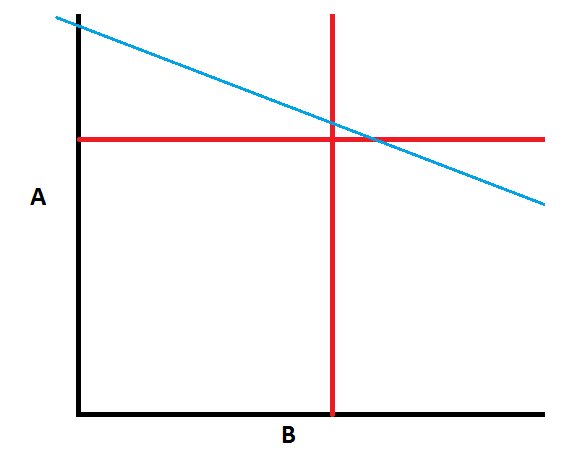The basis of this week’s theory was the moral dilemma. A situation in which one has to choose between two different options, but where one of these options can only be done. Of course, for it to be a true dilemma, the two options must be of equal importance. A moral dilemma is described by the following three rules:
- One ought to do A.
- One ought to do B.
- One cannot do both A and B.
Here the use of ought to implies that a person actually has the moral obligation to do both options, something which cannot be done. This can also be described in a graph, given at the bottom of this column. In the graph, the two red lines represent two thresholds which need to be met for an option to be sufficient. As you can see, there is an area in the top right corner in which both these thresholds are met! Professor Van den Hoven explains that this region can be reached by innovating. Specifically innovating in the field of technology. Let’s apply this theory to an example; namely the refugee problem within the EU. This is a huge moral dilemma for the European Union. On one hand, humanitarian laws require us to offer shelter to anyone that is a refugee because of political or safety reasons. On the other hand, the population protests openly towards the entrance of refugees into their country because they think the big influx of other cultures will overtake their own. So the government is also obliged to protect the culture of its own country. Right now, the only option is to let all the refugees into our countries but keep them from altering our own culture to a large extent. This is hard, but according to Professor Van den Hoven’s principle, it is possible if we find a new way of handling refugees. There is, however, another factor in this particular problem that proves to be a problem; Time. Every innovation requires time to come into existence. If we want to find a way to handle the refugees in a way in which it does not affect our culture, this needs consideration by all member states of the EU. However, this time is just not available.
Huge amounts of refugees are flowing into the EU right now, and all its countries are working around the clock to give shelter to the refugees they were assigned. This means there was little to no time before the exodus of refugees for the EU countries to come up with a new way of providing shelter for people seeking refuge. Only when the influx of refugees has fallen, can the governments commit their time to managing all the new refugee camps in their countries. Until then, camps are hastily constructed or re-opened to cope with the increasing amounts of people that need shelter. This quick strategy is bound to give trouble in the long run, and the governments will have to deal with this as well. Time is the only thing that can show us how to satisfy both constraints that make up this moral dilemma.
